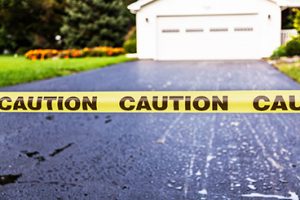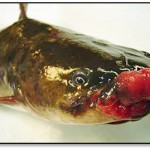In Michigan, coal tar-based sealcoat is applied widely on driveways, parking lots, and even playgrounds. Sealcoat applicators and their customers say the product enhances the look of weathered asphalt surfaces and prolongs product life. However, coaltar sealcoat can pose significant risks to humans and aquatic life.
 Coal tar sealcoats are incredibly high in polycyclic aromatic hydrocarbons, or PAHs. PAHs are of concern because many of these compounds have been identified as toxic, mutagenic, teratogenic (causing birth defects) and/or probable human carcinogens. Coal tar sealants contain 1000 times more PAHs than asphalt-based sealants (a readily available alternative) and are the number one source of PAHs in lake sediments. In fact, studies show up to 50-75% of all PAHs found in sediments within the Great Lakes region comes from coal tar sealcoat.PAHs from coal tar sealcoat are released into the environment in several ways. When applied, these compounds volatilize into the air, affecting air quality. As the sealcoat weathers, dust from the pavement makes its way into homes on shoes and clothing. When it rains, loose particles move into soils, stormwater catch basins, lakes, and rivers.
Coal tar sealcoats are incredibly high in polycyclic aromatic hydrocarbons, or PAHs. PAHs are of concern because many of these compounds have been identified as toxic, mutagenic, teratogenic (causing birth defects) and/or probable human carcinogens. Coal tar sealants contain 1000 times more PAHs than asphalt-based sealants (a readily available alternative) and are the number one source of PAHs in lake sediments. In fact, studies show up to 50-75% of all PAHs found in sediments within the Great Lakes region comes from coal tar sealcoat.PAHs from coal tar sealcoat are released into the environment in several ways. When applied, these compounds volatilize into the air, affecting air quality. As the sealcoat weathers, dust from the pavement makes its way into homes on shoes and clothing. When it rains, loose particles move into soils, stormwater catch basins, lakes, and rivers.




 For someone who spends their lifetime living adjacent to coal tar sealcoated pavement, the average excess cancer risk is estimated to be 38 times higher than the urban background exposure. Much of the increased risk occurs during early childhood. Children play on and near these surfaces and are, therefore, more likely to inhale or ingest PAHs associated with coal tar sealcoat.
For someone who spends their lifetime living adjacent to coal tar sealcoated pavement, the average excess cancer risk is estimated to be 38 times higher than the urban background exposure. Much of the increased risk occurs during early childhood. Children play on and near these surfaces and are, therefore, more likely to inhale or ingest PAHs associated with coal tar sealcoat. In rivers and lakes, PAHs are found primarily in the sediments. Organisms that spend part or all of their life cycle in contact with these sediments can experience adverse effects due to exposure to elevated concentrations of PAHs. Affected organisms include mammals, birds, fish, amphibians and plants. Studies have linked PAH exposure in aquatic animals to stunted growth, reduced reproduction, difficulty swimming, liver problems, altered development, immune system impairment and death.
In rivers and lakes, PAHs are found primarily in the sediments. Organisms that spend part or all of their life cycle in contact with these sediments can experience adverse effects due to exposure to elevated concentrations of PAHs. Affected organisms include mammals, birds, fish, amphibians and plants. Studies have linked PAH exposure in aquatic animals to stunted growth, reduced reproduction, difficulty swimming, liver problems, altered development, immune system impairment and death.